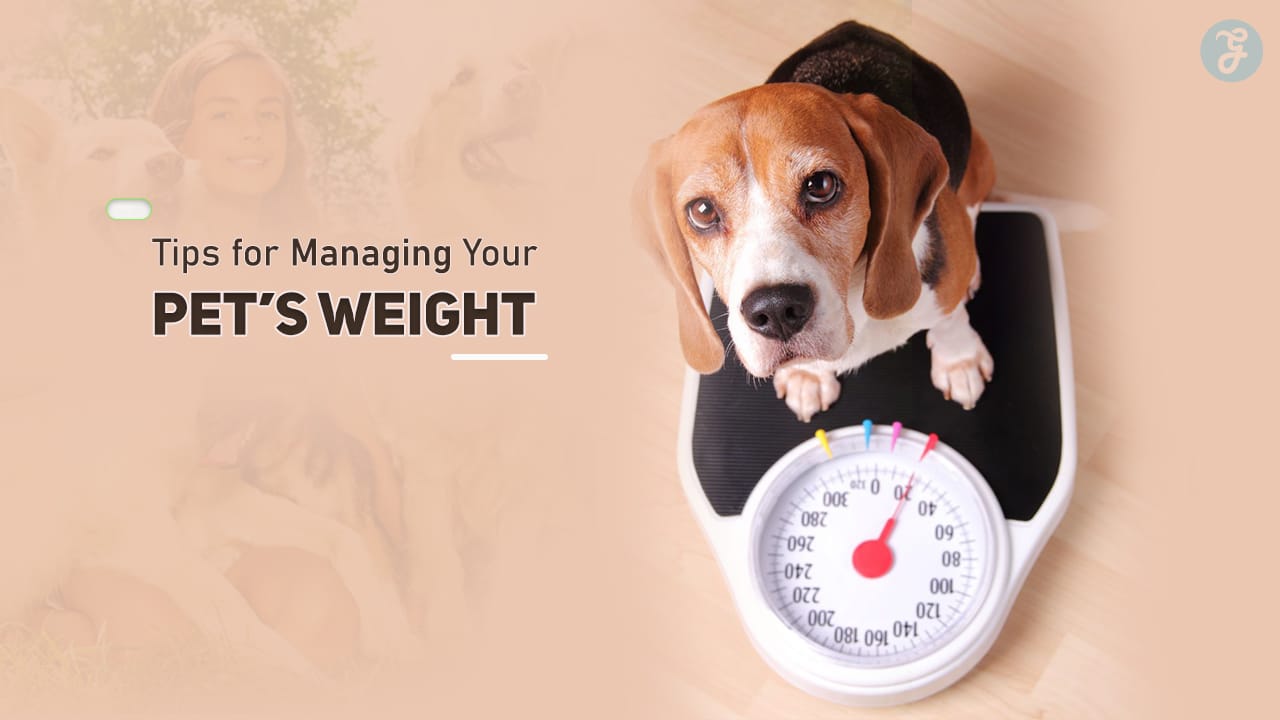With obesity on the rise among pets, managing your pet’s weight is a critical aspect of ensuring a long and healthy life for your furry friend.
Overweight pets are more likely to suffer from a range of health issues, such as diabetes, joint problems, heart disease, and reduced life expectancy.
While every pet’s dietary and exercise needs are unique, there are foundational principles that can help guide you in keeping your pet at a healthy weight.
In this guide, we’ll explore eight practical tips to help you manage your pet’s weight, each backed by veterinarian insights and pet health experts.
By the end of this article, you’ll have a well-rounded understanding of how to create a healthy lifestyle plan for your pet, ensuring they stay fit, happy, and full of energy.
Why Managing Your Pet’s Weight Matters?
Before diving into the tips, it’s important to understand the impact of weight on your pet’s health. Excess weight can lead to severe health conditions, reduce your pet’s energy levels, and even lower their quality of life. Here are some reasons why weight management is essential for pets:
- Reduces Health Risks: Maintaining a healthy weight decreases the likelihood of chronic diseases, such as diabetes, high blood pressure, and respiratory issues.
- Improves Mobility and Joint Health: Extra weight strains your pet’s joints, which can cause arthritis or worsen existing joint problems.
- Increases Longevity: Pets at a healthy weight often live longer and have a higher quality of life.
- Enhances Daily Energy Levels: Keeping your pet’s weight in check boosts their stamina, making playtime and exercise more enjoyable.
8 Essential Tips for Managing Your Pet’s Weight
1. Regular Portion Control
One of the main reasons pets become overweight is overfeeding. Due to their pet’s eagerness for food, many pet owners unintentionally give larger portions than necessary. However, portion control is a fundamental part of weight management.
Tips for Portion Control
- Measure Food with Accuracy: Use a measuring cup to ensure you’re giving the correct portion size according to your pet’s size, age, and activity level. Most pet food brands provide feeding guidelines on the packaging; however, it’s best to consult your vet for personalized advice.
- Set Meal Times: Instead of free-feeding, establish regular meal times. Controlled feeding helps you monitor how much your pet eats and prevents mindless snacking.
- Avoid “Human Food” Scraps: Feeding your pet from the table or giving them treats from your plate can quickly lead to excessive calorie intake. Instead, stick to their regular food to avoid unnecessary weight gain.
Portion Control Table
| Pet Weight (lbs) | Calories per Day | Portion Size (Cups) |
| 5-10 | 100-150 | 1/4 – 1/3 |
| 11-20 | 200-300 | 1/3 – 1/2 |
| 21-40 | 400-500 | 1/2 – 1 |
| 41-60 | 600-700 | 1 – 1 1/2 |
| 61+ | 700+ | 1 1/2 – 2 |
Note: This table is a general guideline. Consult your vet for a precise portion size suited to your pet’s unique needs.
2. Choose Nutrient-Dense, Low-Calorie Foods
The type of food you choose has a huge impact on your pet’s weight and overall health. Nutrient-dense, low-calorie foods help provide the essential vitamins, minerals, and protein your pet needs without excessive calories.
Tips for Selecting Pet Food
- High-Protein, Low-Carb Foods: Pets, especially cats and dogs, thrive on protein-rich diets. Avoid foods with high amounts of grains and fillers.
- Read Ingredient Labels: Choose foods with whole meats as the primary ingredients and avoid fillers like corn, wheat, and soy, which can add unnecessary calories.
- Opt for Fiber-Rich Foods: Fiber helps your pet feel fuller, which can prevent overeating. Many weight-management pet foods include added fiber to aid in digestion and satiety.
3. Incorporate Regular Exercise into Daily Routine
Just like humans, pets require regular physical activity to maintain a healthy weight. Exercise not only helps in burning calories but also improves your pet’s mental health and prevents behavioral issues associated with boredom.
Exercise Tips Based on Pet Type
- Dogs: Aim for at least 30-60 minutes of exercise daily, depending on your dog’s breed, age, and health. Activities can include walking, running, playing fetch, and agility training.
- Cats: Engage cats with toys like laser pointers, feather wands, or treat-dispensing toys. Aim for at least 15-20 minutes of interactive play twice a day.
- Small Animals: Hamsters, rabbits, and guinea pigs can benefit from exercise wheels or supervised playtime outside their enclosures.
Exercise Schedule Table
| Pet Type | Recommended Exercise (Daily) | Activity Examples |
| Dogs | 30-60 minutes | Walking, fetch, agility |
| Cats | 15-20 minutes, twice daily | Interactive toys, laser pointer |
| Small Animals | 20-30 minutes | Exercise wheel, supervised play |
4. Monitor Treats and Snacks
While treats are a great way to reward your pet, they can quickly add up in calories. Over time, excessive treats can lead to weight gain and make it harder to manage your pet’s weight.
Tips for Healthy Treating
- Choose Low-Calorie Treats: Opt for low-calorie treats that are specifically designed for weight management. Avoid treats with high sugar or fat content.
- Limit Treat Frequency: Try to keep treats to no more than 10% of your pet’s daily calorie intake.
- Use Fruits and Vegetables as Treats: Many pets enjoy healthy snacks like carrot sticks, apple slices (without seeds), and green beans, which are lower in calories and rich in fiber.
Treat Calorie Comparison Table
| Treat Type | Average Calories per Treat | Healthy Alternatives |
| Store-Bought Treats | 20-50 | Carrots, green beans, apples |
| Dental Chews | 50-80 | Cucumber slices |
| Meat-Based Treats | 40-60 | Low-calorie kibble |
5. Schedule Regular Vet Check-Ups
Routine check-ups with your veterinarian are essential for keeping tabs on your pet’s weight and overall health. Vets can provide guidance on dietary changes, exercise recommendations, and weight management techniques tailored to your pet’s needs.
What to Expect at a Vet Check-Up
- Weight Monitoring: The vet will weigh your pet and determine if they are within a healthy weight range.
- Body Condition Scoring: Vets use a body condition score (BCS) to assess if your pet is underweight, overweight, or at an ideal weight.
- Personalized Diet and Exercise Advice: Vets can recommend specific foods and exercises based on your pet’s age, breed, and health status.
6. Make Mealtime Interactive with Puzzle Feeders
Puzzle feeders slow down eating and make mealtime more engaging. This can be especially beneficial for pets who eat quickly or are prone to overeating, as it promotes mental stimulation and controls portion intake.
Types of Puzzle Feeders
- Slow-Feed Bowls: These bowls have ridges and barriers that make it challenging for pets to eat quickly, preventing gulping and improving digestion.
- Interactive Food Toys: Toys like treat-dispensing balls or wobble feeders require pets to work for their food, making it both a game and a meal.
- Snuffle Mats: These mats encourage pets to forage for food, which mimics natural hunting behavior and helps them eat more slowly.
Puzzle Feeder Comparison Table
| Feeder Type | Ideal For | Benefits |
| Slow-Feed Bowl | Dogs, Cats | Slows eating, aids digestion |
| Treat-Dispensing Toys | Dogs, Cats | Provides exercise, prevents boredom |
| Snuffle Mat | Dogs, Small Animals | Encourages foraging, mentally stimulating |
7. Track Your Pet’s Weight and Progress
Keeping track of your pet’s weight and body condition allows you to notice small changes that may indicate weight gain or loss. Regular tracking ensures you can make timely adjustments to their diet or exercise regimen.
How to Track Your Pet’s Weight
- Use a Scale: Weigh your pet every 2-4 weeks to monitor changes. Small pets can be weighed at home, while larger pets may need to be weighed at a vet clinic.
- Record Measurements: Keep a log of your pet’s weight, noting any fluctuations and potential causes.
- Take Photos: Photos can help you visually track your pet’s body shape, which is particularly useful for pets with longer fur where weight gain may not be immediately noticeable.
8. Maintain a Consistent Routine
Pets thrive on routine, as it helps them feel secure and minimizes stress. Establishing a consistent feeding, exercise, and playtime schedule can make weight management easier for both you and your pet.
Tips for a Consistent Routine
- Set Feeding Times: Stick to set meal times every day, which helps your pet’s body adapt to a regular eating schedule.
- Establish an Exercise Routine: Create a schedule for walks, playtime, and other activities to ensure your pet gets daily exercise.
- Stay Consistent with Treats: Only give treats at certain times, such as during training sessions or after exercise, to avoid unplanned snacks.
Conclusion
Managing your pet’s weight is essential for their overall health, happiness, and longevity. From portion control and healthy treats to regular exercise and routine vet visits, these tips will help you keep your pet at a healthy weight.
Remember, every pet is unique, and what works for one may not work for another, so always consult your veterinarian when making changes to your pet’s diet or exercise routine.
With consistent effort and care, you can ensure that your furry friend stays fit, active, and healthy for years to come.








































